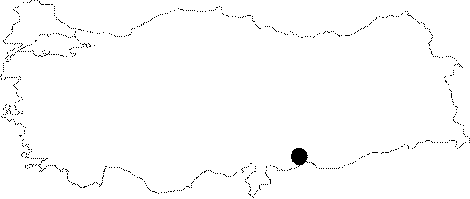|
©The Archaeological Settlements of Turkey - TAY Project
|
|
|
|
|
|
Fistikli Höyük |
|
|
For site maps and drawings please click on the picture...  |
For photographs please click on the photo...  |
|
Type:
|
Mound |
|
Altitude:
|
485 m |
|
Region:
|
Southeastern Anatolia |
|
Province:
|
Sanliurfa |
|
District:
|
Birecik |
|
Village:
|
Mezraa |
|
Investigation Method:
|
Excavation |
|
Period:
|
|
|
|
|
 |
|
| Location: The mound lies west-southwest of Sanliurfa; about 4 km south of Birecik; 1.5 km north of Mezraa village. The settlement is situated on the left bank of the Euphrates; about 25 km upstream from Karkamis and within the Karkamis Dam area. The site was first described by Algaze as Zeytinli Bahçe Yani I in the previous publications [Algaze et al.1994:45-46;har.5(45 site no)]. |
| Geography and Environment: The site is located on the east end of Euphrates flood plain; at a point close to the limestone bluffs which border the plain. It is a small and shallow mound covering an area of 0.5 ha; maximum 4 m high from the plain. Today; the site is covered with pistachio trees. There are contemporary houses on the southern foot and the slopes of the mound are being cultivated. |
| History: |
| Research and Excavation: It was first visited during the survey conducted by G.Algaze, followed by another visit in 1998 by a team under the direction of S. Pollock and R. Bernbeck. Excavations were conducted in the site in 1999-2000. |
| Stratigraphy: Fistikli Höyük is a small settlement which was occupied during the early phase of the Halaf Period. Being abandoned following this period, it was not reoccupied for many millennia. Presence of a restricted number of sherds suggests occupation during the Iron Age. However, majority of the evidences for the post-Halaf occupation is from the Late Hellenistic and Early Roman Period. Although these finds suggest presence of inhabitation, it appears that it was principally used as a burial and dumping ground [Pollock et al. 2001:23-24]. |
| Small Finds: Pottery: The sherds collected from the site can be divided into two groups: Halaf and post-Halaf. The cooking pots among the post-Halaf ware are dated to the Iron Age or later periods [Pollock et al. 2001:10]. |
| Remains: |
| Interpretation and Dating: Known as a significant Halaf Period settlement, Fistikli Höyük is less likely to have been occupied during the Iron Age due to a very restricted number of finds dating to that period. |